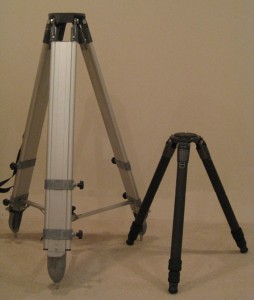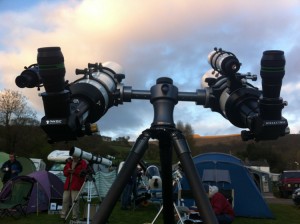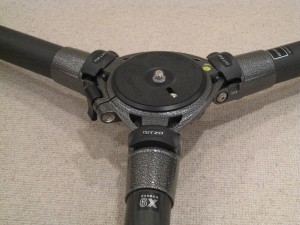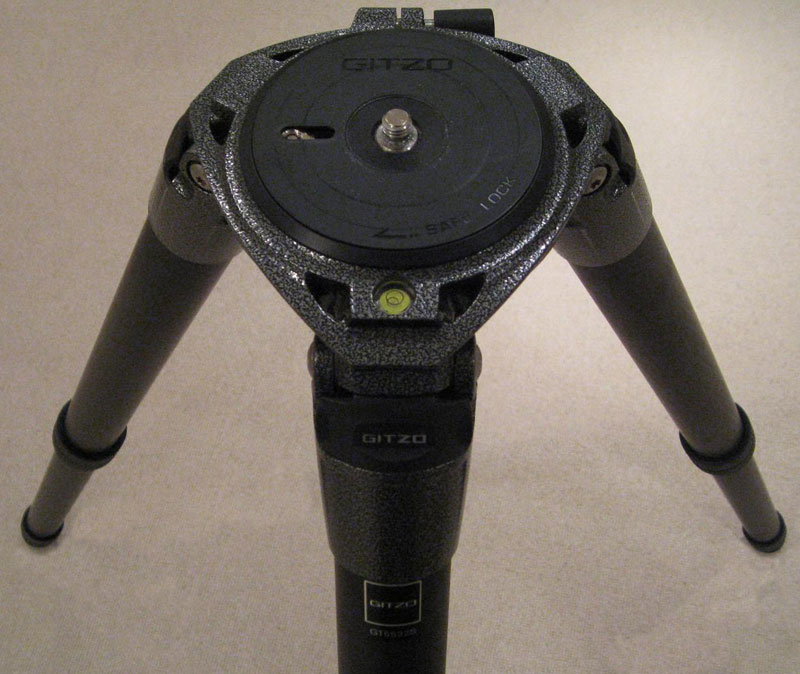
While functionally offering similar levels of performance, one of these is quite a bit easier to travel with (Both shown at closed length).
The observing experience provided by a telescope will always be limited by its weakest component. I have seen optically good telescopes ruined by meagre mounts, low quality eyepieces pushed past their limits by fast focal ratios or a complete lack of stability due to a wobbly tripod robbing the observer of any hope of seeing fine detail. Many an astronomer has been guilty of underestimating the importance of a solid base to a successful night of astronomy and when travelling, especially to foreign lands in search of dark skies, this can be a real problem. The simple fact is astronomical tripods are often very large and extremely heavy which can be a real stumbling block when an aircraft baggage allowance is the limiting factor.
After booking a holiday to Oman in early 2012, which would include a stay in the desert hundreds of kilometres from any light pollution, I began putting together a package of an airline transportable telescope and other required equipment. The selected optical tube assembly was the APM TMB 105/650 LW triplet Apochromatic refractor (read the review here), which weighs approximately 6kg (13.2lbs) including the tube rings, and with finder, 2” mirror diagonal and eyepiece, exceeds 7kg. For the mount, I selected the Alt-Az Tele-Optic Giro Ercole which weighs 4.3kg and is able to support up to 18kg, though when using an OTA weighing less than 8kg, counterweights are not required. Crucially my telescope and accessories kept below that limit which allowed me to travel without additional weights. However, when it came to selecting a tripod, I hit my first hurdle. As the trip to Oman was not a dedicated astronomical holiday, I decided that other than using my cabin baggage to transport the OTA and eyepieces, I was not prepared to carry any additional luggage other than my largest suitcase which would be holding all my clothing for a two week trip. All the dedicated astronomical tripods I own are far too long and heavy to allow fulfilment of that imposed requirement. The search was on for a new tripod with a closed length of less than 65cm, while also being as light as possible so my suitcase would comply with the airline maximum weight allowance of 23kg but still provide me with a solid, stable base so I could spend the nights stargazing. After a long search I discovered the Gitzo 6X Carbon Fibre tripod range.
While the Series 4 Gitzo tripods, with their maximum load capacity of 25kg would most likely have been sufficient, being unsure how well suited these tripods would be when observing at over 200x magnification, I selected the Gitzo Series 5 GT5532S which boasts a 40kg maximum load and higher torsional rigidity.
The Systematic tripods are Gitzo’s top of the range and it shows the moment you remove the tripod from its textile drawstring anti-dust-bag. The excellent build quality and workmanship is very evident and the combination of the 6X carbon fibre and magnesium castings with “noir decor” finish is quite striking. The noir decor coating is not just for show and actually gives the products a stronger, longer lasting finish. Included on the top triangular shaped casting element is a bubble spirit-level as well as an inbuilt lock ratchet lever for a no-tool removal of the standard equipment flat top plate with 3/8” screw head, should you wish to add a geared or sliding centre column. An additional safety feature is a release button on the underside which must be pressed to release the head once the lever has loosened the grip on the top plate.
The G-Lock is my favourite feature found on the 5532s. Unlike many tripods which use latches, Gitzo employs a twist-lock system which is very quick and easy to use. Simply rotate each twist lock to loosen, extend the legs out, and then retighten each lock. The tripod employs an anti-leg-rotation system which allows all the leg sections to be pulled out and tightened in one go meaning the tripod can be set up in as little as 20 seconds. While the quick set up is convenient, I particularly appreciate this method as it is far easier on the hands when packing away for a night in freezing temperatures and I do not have to fiddle with awkward latches. The carbon fibre legs also stay warmer to the touch than aluminium which I have been thankful for more than once during the winter.
The two telescopes I use on the GT5532S regularly see magnifications in the range of 150 to 250x. At those powers, any vibrations will appear like an earthquake in the eyepiece. As such the stability of the system employed as well as the damping characteristics are of the upmost importance if you do not want a lesson in frustration when out under the stars. I typically place around 12kg (26.4lbs) of telescope, mount and accessories on the tripod and I have found the GT5532S provides a very stable base with an excellent damping time of around one second. Even a deliberate whack on the tripod sees the vibrations die down in less than 2 seconds. The damping time was my biggest concern before purchase as trying to find precise focus on a planet when the image is constantly dancing around the field of view can be very challenging, but I need not have worried.

Two 4″ class triplet refractors with a combined weight including the mount of 20kg sitting atop the GT5532S
I have put the tripod under extra stress by mounting two telescopes simultaneously, as I did when I was testing my two 4” class triplet refractors side by side with a combined weight (including the mount) of approximately 20kg (44lbs). When observing like this, most of that mass is offset substantially from the centre of the tripod. Even under this test, the tripod proved to be a very stable base.
Gitzo uses “Carbon 6X” tubes in the construction of its tripods. Each tube is made of six crossed layers of 7μm thick carbon fibres. The top leg of the series 5 tripods have a diameter of 41.2mm (1 5/8”) and the GT5532S only has 3 leg sections with the lowest leg having a diameter of 32.2mm (1 1/4”) which adds to the stability and it is generally considered to be the most rigid tripod in the entire Gitzo range because of this.
The tripod benefits from built-in one piece spiked feet which are covered with protective rubber caps which are more than suitable for everyday use. I tend not to remove the rubber feet when using the tripod but should you wish to it is relatively straight forward exercise to twist and pull, though I would highlight there is no risk that they would be lost in the field.
While not a feature I use for astronomy, anyone who would look to use this tripod for photography will be pleased to know that the GT5532S features leg angle selectors which are useful if setting up on uneven terrain or if you wish to shoot from low to the ground. The minimum height is only 10.3cm (4.1”) as seen in the accompanying photograph.

Using the easy to set angle selectors, the GT5532S can be set to a minimum height of only 10.3cm (4.1″)
At only 2.8kg and with a closed length of 62.8cm, the tripod fits in a small tripod bag when I am travelling locally and easily fits inside my largest suitcase and does not utilise too much of my baggage weight allowance when I travel abroad comfortably fulfilling one of my primary requirements when I first started my search.
If I do have one criticism, it would be that the light weight of the tripod means it can be buffeted more by the wind than other tripods that have similar load capacities but are far heavier. However, there is a hook on the underside of the mounting plate which allows for the hanging of a stabilising weight though I have not used it myself. Gitzo actually recommends its use during windy conditions.
Conclusion
I am exceptionally pleased with the performance of the Gitzo Systematic Series 5 GT5532S tripod. The high load capacity, torsional rigidity and good damping time, combined with the short collapsed size and the sub 3kg weight is a no compromise solution to the original brief I set, though it is a high cost one. With an RRP of £869.95 the price is high but I feel the performance and convenience more than compensates for the cost. I would encourage anyone interested in the GT5532S to shop around as I was able to purchase the tripod over £160 cheaper than the list price.
The only real weakness I found is that its light weight does make the tripod more susceptible to vibration in windy conditions than heavier tripods with comparable load capacities, though this can be remedied by using the installed hook to hang some weights. Even considering this minor limitation, I now find that I use the GT5532S even when observing at home or on trips domestically with one of my 4” telescopes due to the ease of use and lack of bulk.









Pingback: hink Tank Photo Airport Security V2 Camera Bag Review | Alpha Lyrae
Pingback: Tele Optic Giro Ercole Alt Az Mount Review | Alpha Lyrae
Pingback: Gitzo Systematic GT4552TS Carbon Fibre Tripod Review | Alpha Lyrae
Pingback: APM LZOS 115 Triplet Apo Refractor Review | Alpha Lyrae
Pingback: Review of the TeleVue Nagler Zoom Eyepiece | Alpha Lyrae
Subsequent to this review have you been able to try / observe a Series 4 tripod (more compact/somewhat lighter) in successful use for astronomical purposes with comparable loads?